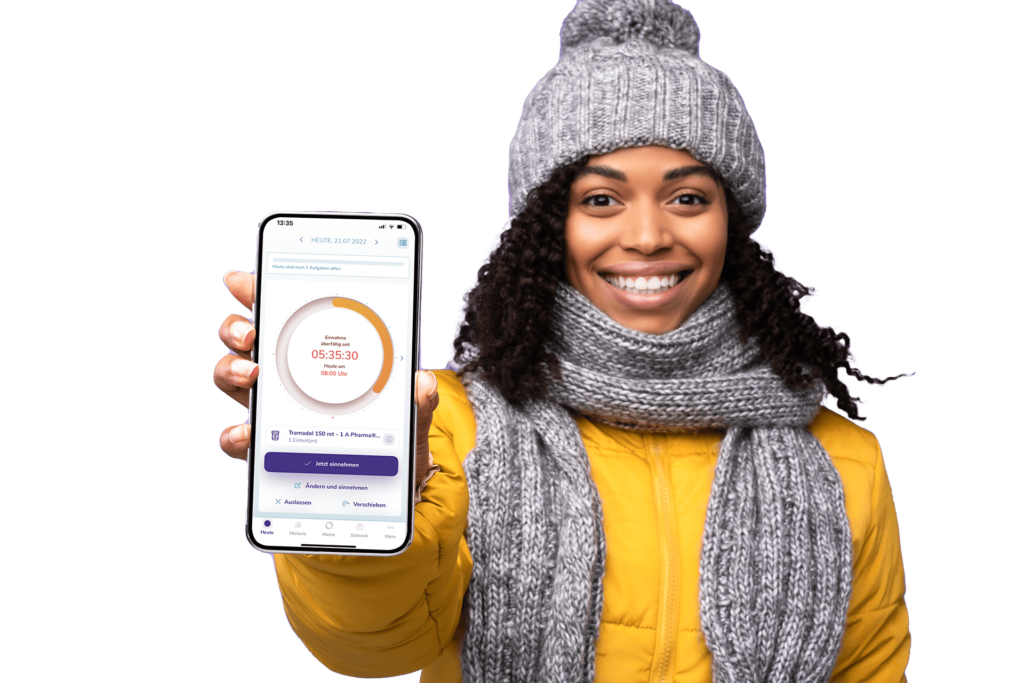According to the World Health Organization (WHO), only about half of people suffering from a chronic disease take their medication as prescribed.[1] Other studies also report similar numbers that vary by disease.[2] This should alarm patients, health care providers, payers, the economy and the public sector alike, because the negative consequences of this non-compliance with prescribed treatment, called treatment infidelity, are enormous. We describe why patients find it difficult to follow treatment recommendations. We shed light on the direct and indirect impact this treatment infidelity can have not only on patients, but on society. And we show how adherence to therapy can succeed and be increased by using the TOM app
Challenges for patients
It is common knowledge that many people under medical care have difficulty following treatment recommendations, especially when chronic disease processes are involved. Non-adherence to medical recommendations can vary significantly depending on the patient, the condition, and even the medication.
The reasons are manifold. The treatment itself may be unpleasant, interfere with daily work or private life, or be accompanied by side effects. Patients may be confused, on the one hand by conflicting medical advice from multiple specialists or by freely available information from the Internet. In part, the importance to follow therapy may not have been communicated clearly enough according to the patient’s capacity to receive it or presented in an understandable way. Consultation options or targeted therapy monitoring after the start of treatment are often not provided or close enough. Additional concerns on the part of the patient or a lack of motivation, in combination with the aspects already mentioned, then lead to neglect of the agreements made or even discontinuation of the therapy, especially since the benefits of the treatment often only become apparent after a while.
Adherence to therapy – therapy adherence – does not only mean taking medication regularly and according to the instructions. It means for the patient to play an active role in the treatment, to take responsibility for compliance with medical recommendations and to permanently adjust his behavior (e.g. lifestyle, diet, exercise, as well as regular, correct intake of medication).
With adherence to therapy, health can succeed
The benefits of strict adherence to therapy for patients and especially patients with chronic disease courses are obvious. We have listed some of these here; of course, these may vary depending on the clinical picture and patient sociography and may change as the disease progresses:
- better health and well-being
- Halt or delay progression of the disease
- Avoid further complications
- Fewer recurrent episodes of illness and (re)admission rates.
- Increased patient safety through minimized risks
- more quality of life.
Proactive strategies that support adherence to medical treatment recommendations enable many chronically ill people to continue to engage in regular work or to return to work after a period of rehabilitation.
Society also benefits – A look at the other side
Adherence to therapy not only improves people’s health, but also ensures cost savings in healthcare and a productivity boost in the economy. Chronic diseases in particular lead to major economic losses every year.[3]
Productivity losses occur due to «presenteeism» (presence with limited ability to work), absence due to illness or even incapacity to work. Thanks to strict adherence to therapy, many chronically ill patients are able to continue working or return to their jobs after a period of rehabilitation. Productivity improvements are particularly important in areas where there is a shortage of skilled workers and labor or where demographic change is having a negative impact on the structure.
It is accepted that the cost of lost productivity is on par with direct medical benefit expenditures.[3]
But it’s not just the employer who benefits from increased therapy compliance; the public purse does too. Less incapacity to work means, for example, fewer social benefits and higher tax revenues.
Although better treatment adherence means immediately increasing treatment costs, in the medium and long term the need for treatment and care can be reduced compared to non-adherent patients.
Although all of those mentioned should have an interest in promoting practices that facilitate treatment adherence, the motivation and commitment to do so is not the same for everyone. Medical providers in particular, who have the most direct contact and thus the greatest influence on patients, are largely focused on diagnosis and treatment recommendation. In purely economic terms, they have the least incentive to implement adherence-promoting strategies. This is because treatments are disproportionately weighted compared to therapy monitoring.
Therefore, it will be important to generate robust data demonstrating the benefits of adherence at all levels so that legislators are prepared to institutionalize adherence-promoting treatment guidelines.
Interventions that improve treatment adherence
Interventions can be divided into strategies that actively promote optimal adherence and those that monitor adherence. They should be based on the stage of therapy and ideally distinguish whether therapy should be started, implemented, or continued.[4]

Evaluation of successful strategies to promote treatment adherence shows that face-to-face counseling models (direct interventions) are similarly successful to indirect interventions (e.g., materials sent electronically, by mail, or by fax).[5] For example, it was found that patients’ adherence to statins improved significantly after 12 months with advice and support from the pharmacy.[6]
A 2016 meta-analysis (16 RCTs, 2742 patients total) reported that text messaging doubled the likelihood of medication adherence and improved it by 17.8% overall.[7] Mobile notifications were also shown to be effective in improving adherence to weight loss medications.[8]Mobile Benachrichtigungen zeigten sich auch wirkungsvoll in der Verbesserung der Therapietreue bei Medikamenten zur Gewichtsreduktion.[9]
But measures that make taking medication clear and simplify it are also proving effective. This includes, for example, special dosettes or, of course, a medication schedule, whether in paper or digital form, as an app.
mHealth applications help integrate individual therapy adherence into daily life
Thanks to growing acceptance and advancing digitization, mobile health (mHealth) interventions are already well-used everyday companions that help patients take their medication.[10],[11],[12]
Many people own smartphones, and smartphone applications (apps) provide a scalable and cost-effective way to intervene. There are now more than 5000 apps that support medication adherence, but there are relatively few studies that have examined their effectiveness.[13] A 2020 meta-analysis (9 RCTs, 1159 patients total) found that app users were more likely to adhere to prescribed medications than participants without an app, but the average study duration was only 12 weeks.[14]
A cutting-edge Australian study provides the first evidence that app-based interventions increase adherence to treatment and that positive behavior change in medication adherence also produces longer-term improvements in clinical parameters in multimorbidity.[15]
What the TOM app can do – 1 year in facts
With the TOM app from the Zurich-based startup Innovation 6, a digital medicine cabinet has been available for about 1 year:

Medicine cabinet, which has it «IN» itself
- 120000 Medications
- Comprehensive management functions: Reminder intake time, intake duration, inventory check, reordering at the push of a button.
- Safety during intake and handling: detailed intake instructions, stored expiration dates, avoidance of overmedication, detection of therapy deviations
- No user registration required
- Anonymous medication check by TopPharm pharmacy
- Encrypted data transmission and storage via 12-digit code
Relative to the known usage time of other mHealth apps (benchmark 30 days), the TOM app shines with a 5x higher engagement rate.
APPLICATIONS
The TOM app is mainly used at:
- Cardiovascular disease (hypertension / elevated cholesterol)
- Metabolic diseases (diabetes) and
- Neurological diseases (epilepsy)
.
However, it is also used in therapies for the treatment of asthma, cancer, multiple sclerosis, mental illnesses such as depression, and in transplant medicine.
FIGURES that speak for the TOM app
Recent evaluations show that of a total of 100,000 TOM users, 82% are still taking their medications according to plan after 1 year. This also means that only 18% of users did not adhere to the medical guidelines during this period. In comparison, an average of 30% non-adherent patients is usually assumed, although the numbers vary depending on the disease.[16]
According to a model calculation by SantéSuisse,[17] which in turn is based on a study by the Bertelsmann Foundation from 2012 3 the theoretically calculated savings potential for 110,000 chronically ill patients is around 4 billion Swiss francs if they were to remain faithful to their therapy. Although these figures depend on many assumptions and are not very reliable, they certainly show the magnitude of the savings that can be achieved by improving adherence to treatment.
There are an estimated 2.2 million chronically ill people in Switzerland. Assuming an average treatment nonadherence of 30%, approximately 660,000 chronically ill patients would not adhere to their treatment regimens. If one continues the calculation already started, this would result in a theoretical savings potential of around 24 billion Swiss francs in total.
An increase in adherence from about 70% to 82% in the case of the TOM app means, at least in the model, that an additional 265,000 chronically ill patients would be adherent to therapy through use of the TOM app, along with the corresponding health and economic benefits.
Plan holistic strategies that lead to treatment adherence.
Lack of adherence is one of the most central reasons for treatment failure.[18] Experts have been discussing the importance of treatment adherence for people and society for years, even decades. However, there is still a lack of systematic, cross-cutting implementation of adherence-promoting measures. There is a need for holistic programs that reach and motivate patients on the one hand and demonstrate the benefits for all sectors of society on the other.
Apps support an urgently needed reorientation of health services research and contribute to the ability to measure effects through treatment adherence in a science- and evidence-based manner.
Thanks to mHealth applications such as the TOM app, application data is generated that can be used to demonstrate the effective benefits of adherence. An evidence base is created that facilitates the ability of various stakeholders to embed adherence-promoting interventions across domains in best-practice recommendations, guidelines, and legislation. For the good of all.
Adherence to therapy concerns us all – TOM Medications makes its contribution
Therapies only work if patients take the right drugs in the right dosage and at the right time. And regularly and exactly as long as prescribed.
It is understandable that the more medications a patient takes and, above all, the longer the therapy lasts, the more complicated this becomes.
The TOM -App is the perfect therapy companion. It promotes adherence to therapy and helps monitor compliance over the long term. It not only assists in personal medication management, but provides valuable practice data on the effective use of app and adherence in relation to disease progression, quality of care, and productivity.
SOURCES:
[1] Sabaté E. Adherence to long-term therapies: evidence for action. Genf: Weltgesundheitsorganisation . 2003. www.who.int/chp/knowledge/publications/adherence_report/en/. Accessed Aug 30, 2021.
[2] Hichborn J, Kaganoff S, Subramanian N, et al. Improving patient adherence through data-driven insights. PHARMACEUTICALS & MEDICAL PRODUCTS PRACTICE. 2018. Retrieved 30 August 2021, from https://www.mckinsey.com/industries/pharmaceuticals-and-medical-products/our-insights/
[3] Behner P, Klink J, Visser S, Böcken J, Etgeton S. Effekte Einer Gesteigerten Therapietreue: Bessere Gesundheit Und Höhere Arbeitsproduktivität Durch Nachhaltige Änderung Des Patientenverhaltens. Booz & Company, Berthelsmann-Stiftung. 2012. https://www.bertelsmann-stiftung.de/fileadmin/files/BSt/Presse/imported/downloads/xcms_bst_dms_36214_36215_2.pdf. Accessed August 30, 2021.
[4] Vrijens, B, et al., A new taxonomy for describing and defining adherence to medications. Br J Clin Pharmacol. 2012;73:691-705.
[5] Cutrona SL, Choudhry NK, Fischer MA, et al. Modes of delivery for interventions to improve cardiovascular medication adherence. Am J Manag Care. 2010;16(12):929-942.
[6] Taitel M, Jiang J, Rudkin K, et al. The impact of pharmacist face-to-face counseling to improve medication adherence among patients initiating statin therapy. Patient Prefer Adherence. 2012;6:323-329.
[7] Thakkar J, Kurup R, Laba TL, et al. Mobile telephone text messaging for medication adherence in chronic disease: a meta-analysis. JAMA Intern Med. 2016;176(3):340-349.
[8] Li A, Cunich M, Fuller N, et al. Improving adherence to weight-loss medication (liraglutide 3.0 Mg) using mobile phone text messaging and healthcare professional support. Obesity. 2020;28:1889–901.
[9] Li A, Cunich M, Fuller N, et al. Improving adherence to weight-loss medication (liraglutide 3.0 Mg) using mobile phone text messaging and healthcare professional support. Obesity. 2020;28:1889–901.
[10] Bailey SC, Belter LT, Pandit AU, et al. The availability, functionality, and quality of mobile applications supporting medication self-management. J Am Med Inform Assoc. 2014;21:542–6.
[11] Choudhry NK, Krumme AA, Ercole PM, et al. Effect of reminder devices on medication adherence: the remind randomized clinical trial. JAMA Intern Med. 2017;177:624–31.
[12] Peng Y, Wang H, Fang Q, et al. . Effectiveness of mobile applications on medication adherence in adults with chronic diseases: a systematic review and meta-analysis. J Manag Care Spec Pharm. 2020;26:550–61.
[13] Morawski K, Ghazinouri R, Krumme A, et al. Association of a smartphone application with medication adherence and blood pressure control: the MedISAFE-BP randomized clinical trial. JAMA Intern Med. 2018;178:802–9.
[14] Armitage LC, Kassavou A, Sutton S. Do mobile device apps designed to support medication adherence demonstrate efficacy? A systematic review of randomised controlled trials, with meta-analysis. BMJ Open. 2020;10:e032045.
[15] Li A, Del Olmo MG, Fong M, Sim K, Lymer SJ, Cunich M, Caterson I. Effect of a smartphone application (Perx) on medication adherence and clinical outcomes: a 12-month randomised controlled trial. BMJ Open. 2021;11(8):e047041.
[16] https://www.tagesanzeiger.ch/sonntagszeitung/fehlende-therapietreue-kostet-milliarden/story/20037992
[17] https://www.santesuisse.ch/fileadmin/sas_publication/pdf/2012/de_iss_nr_06_2012_de.pdf
[18] Unger-Hunt L, Dörflinger R. Adhärenz bei Hypertonie. Journal für Hypertonie. 2017; 21(2):43-47.







